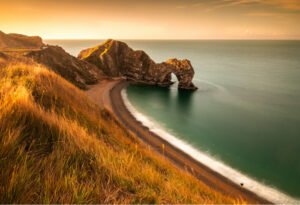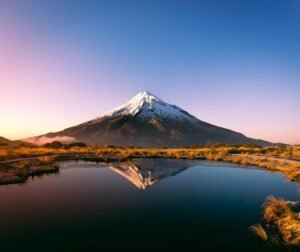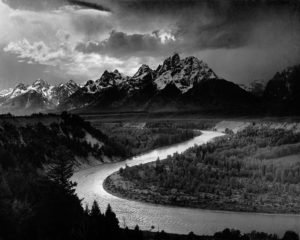A tripod is an essential piece of equipment for landscape photographers. Not only does it provide a stable base for your camera, but it also allows you to use long exposures for capturing the movement of water or clouds. In this article, we will discuss some factors to consider when choosing a tripod for landscape photography, as well as our top picks for the best tripods on the market.
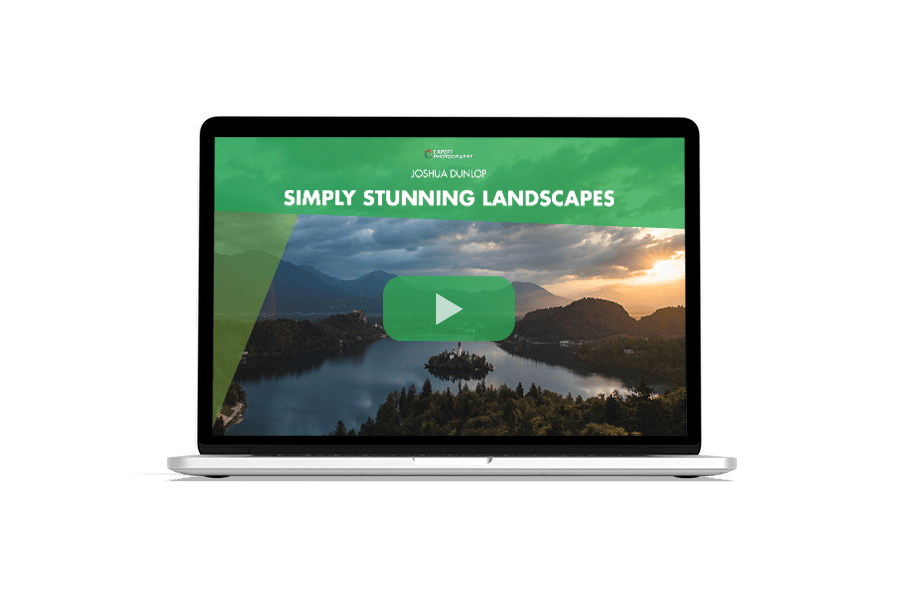
Why Do You Need A Tripod For Landscape Photography?
Some people do not like having to carry a tripod, as they can be bulky, heavy, and slow to set up: a street photographer, for example, will probably never use a tripod, has he needs to ‘catch the moment’ in a split second as it presents itself.
But landscape photography is all about planning the shot and waiting for ideal light—speed is not essential.
The whole point behind having a tripod is to keep your camera rock steady while you set up your camera and filters for your shot and to avoid unwanted camera shake when shooting in low-light conditions (nighttime landscapes, golden and blue hours) or when you shoot for HDR, panoramas, long exposures, and other types of landscape photographs.
For this reason, a good tripod has always been an important item in the landscape photographer‘s toolbox.

How to Buy a Sturdy Tripod
- Choose a tripod with a maximum load 20-30% higher than the total weight of the gear you will mount on it.
- Consider that extending the center column can reduce your camera stability, therefore choose a tripod that can be set high enough without having to fully extend its central column.
- Three-sectioned legs are generally more stable than four- or five-sectioned legs.
When shopping for a tripod, do not forget to include in your budget a good tripod head: a flimsy head will make every professional camera tripod perform like the cheapest of toy tripods.
What to Look For in a Tripod for Landscape Photography
- As you will be carrying your tripod for long distances on rough terrain, if weight is a concern consider buying a tripod made of carbon fiber, which is a lighter material than aluminum or other metals.
- Tripod size is another key aspect to consider: full-sized tripods are larger and heavier than compact or travel tripods (which are built to fit in most camera travel backpacks and hand luggage).

- If you value flexibility over a tripod’s size and weight, a full-sized tripod will generally allow you to compose from down low up to high above eye level.
- Independent, multi-angle legs are a must to safely set up the tripod in rough and uneven terrain.
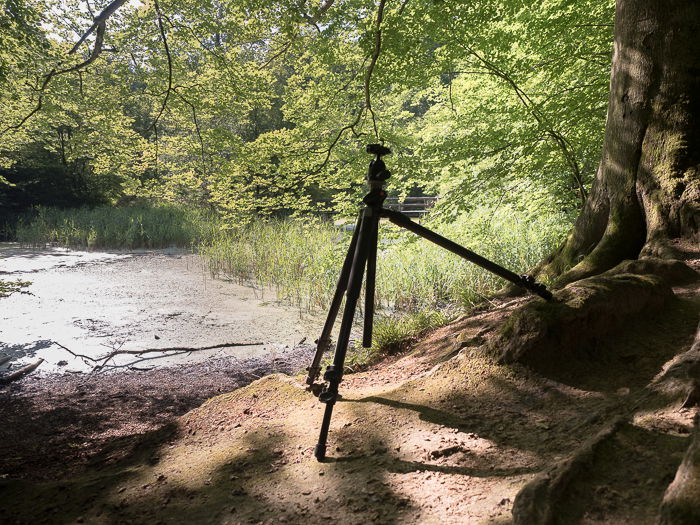
How to Properly Set Up Your Tripod
Setting up a tripod is not rocket science, but there are few tips you should know to ensure you get the maximum stability from your tripod:
- Always extend the larger sections of the legs first.
- Always fully extend the legs first and raise the central column only if you need that extra height.
- When setting up the tripod on soft ground, such as mud or wet sand, put a flat stone or similar object under each foot to distribute the weight onto a larger surface. Some manufacturers offer optional feet with larger surface areas.
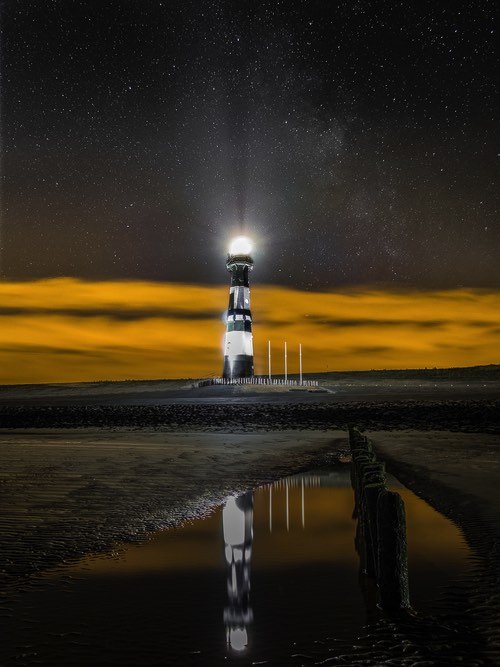
For night landscape photography on the beach, you need a stable tripod and careful set up to avoid any movement on the wet sand. - To further stabilize tripods (e.g. carbon fiber tripods) against strong wind, attach your backpack to the tripod with a short bungee cord to give the tripod some weight. Make sure your backpack is still touching the ground and not swinging in midair. This is the reason for the little loop some tripods have near the central column.
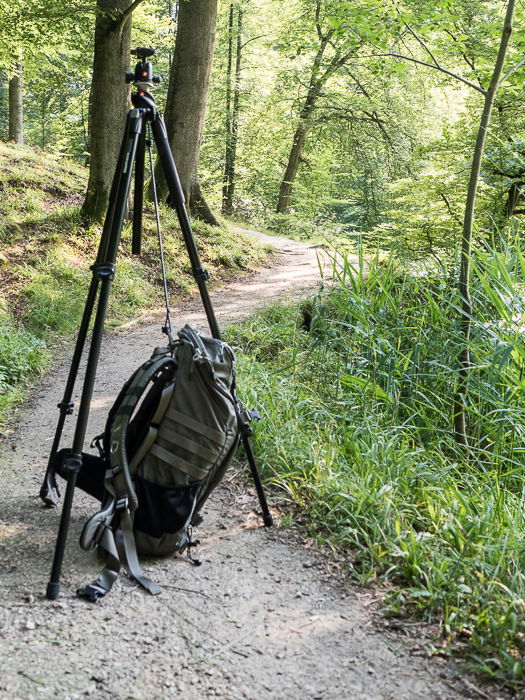
Kinds of Tripods
Tripods are typically defined as compact, travel, or full-size depending on how small they fold: anything that folds into a package that will easily fit into a hand luggage or camera bag, (eg. shorter than 20″) is considered a travel tripod. Anything larger goes under the so called full-size tripods category.
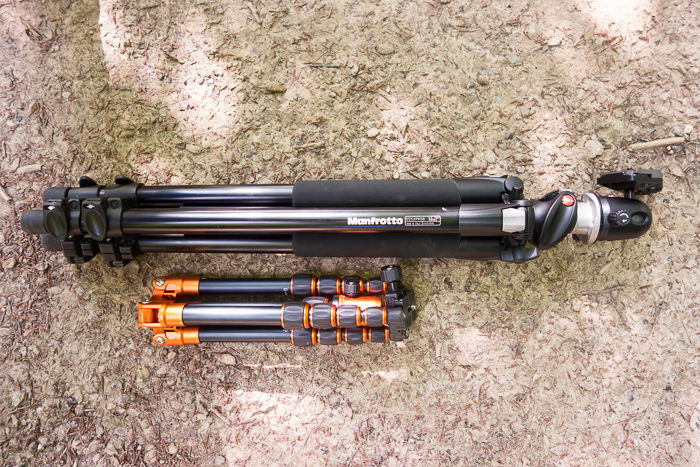
Sometimes, tripods which fold into a very small size are called compact tripods and those are generally less stable and much shorter than full-size tripods. These cannot support as much weight.
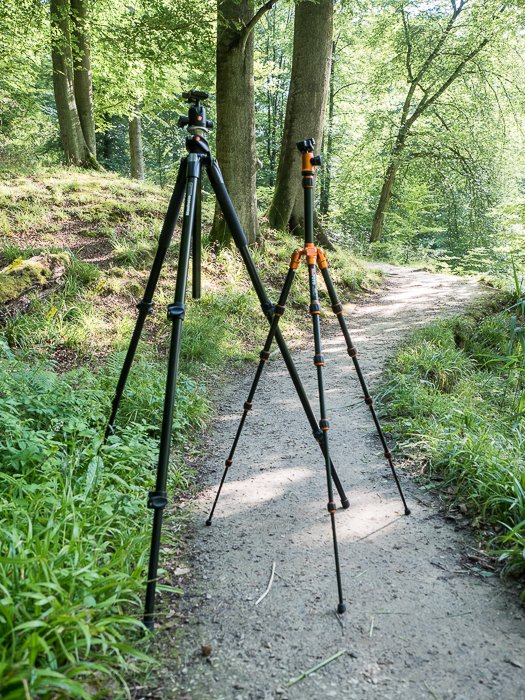
How small a tripod folds is related to the number of sections that make up the tripod legs; fewer sections generally correspond to greater stability. Full-size professional tripods rarely have more than three sections per leg.
Some of the Best Affordable Tripods for Landscape Photography
If you are shopping for a good tripod you should have a look at what reputable brands such as Manfrotto, Gitzo, Benro, Vanguard, Cullmann, MeFOTO, and Giotto propose in their lineup.
Serious and professional photographers and video photographers should look at the very high-end tripods, like those made by Really Right Stuff which are able to safely support more the 20 kg of gear while weighting little more than 2 kg.
In this section I will present few affordable brilliant tripods for landscape photography on the market.
[ExpertPhotography is supported by readers. Product links on ExpertPhotography are referral links. If you use one of these and buy something we make a little bit of money. Need more info? See how it all works here. —Ed.]
Manfrotto 055XPROB: My Go-to, Full-size Tripod
I have already mentioned that I own and love this tripod and, even if now discontinued, I still consider it to be one of the best professional tripods for anyone looking for a serious tripod at a reasonable price.
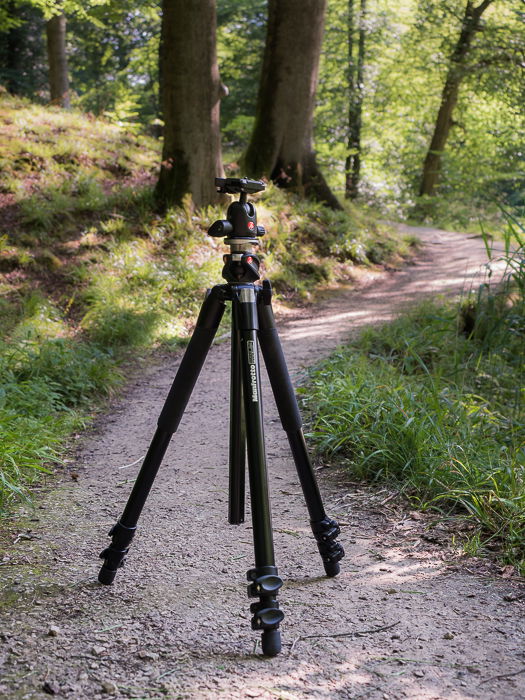
Here an excerpt from the full specifications you can find for this tripod.
- Material Aluminum alloy
- Maximum Height 70.3″ (178.5 cm) || Maximum Height w/o Column Extended 55.9″ (142 cm) || Minimum Height 3.9″ (10 cm)
- Folded Length: 25.8″ (65.5 cm)
- Load Capacity: 15.43 lb (7 kg)
- Total Weight: 5.29 lb (2.4 kg)
- Leg Sections: 3
- Leg Tube Diameters: 29.4, 25, 20 mm
- Independent Leg Spread: Yes, 23, 45, 65, 88°
- Reversible Column: No, horizontal 180° column feature
- Column Tube Diameter: 28 mm
- Bubble Level: Yes
If you are a beginner picking up your first tripod, it can be difficult to relate those numbers to how well the tripod will fit your needs, so here is how I made sense of those numbers to decide that this tripod was good for me:
- The maximum load is enough to support my heaviest gear combo for astrophotography and the 3 sectioned legs (which spread out to a generous diameter), and the lever lock mechanism makes it stable and quick to set up.

The author’s Manfrotto 055XPROB supporting the Skywatcher Star Adventurer tracking head with 1 kg counterweight on a dove plate, a Manfrotto 496CR2 ball head and the author’s Olympus OM-D EM-5 Mark II camera with Zuiko OM 200 f/4 telephoto lens. 
This is the Orion Nebula, captured in winter with the set up shown in the previous photo. This would have been impossible to get with a cheap, entry level tripod. - Independent, multi-angled leg spread enables it to cope with uneven terrain.
- The wide working height range of 168 cm provides great flexibility in framing and composing the scene.

The Manfrotto 055XPROB in its minimum height configuration. - Aluminum construction: I consider this to be a plus over carbon fiber despite the increased weight. Should you drop the tripod or knock it down, aluminum absorbs lateral impacts and knocks better than carbon fiber.
- This is not a number in the specs, but it was reasonably priced (about 150 Euros at the time I bought it), although the head was not included.
Because these benefits largely compensate for the tripod weight and size, I went for it and I am still happy with it.
For Enthusiast/Pro Landscape Photographers: Manfrotto 055XPRO3
Manfrotto is a reputable and historic brand for tripods, monopods, camera accessories, and studio equipment. I have already praised the now-discontinued Manfrotto 055XPROB, but its legacy is even better.
The Manfrotto 055XPRO3 is available both in aluminum and in carbon fiber.
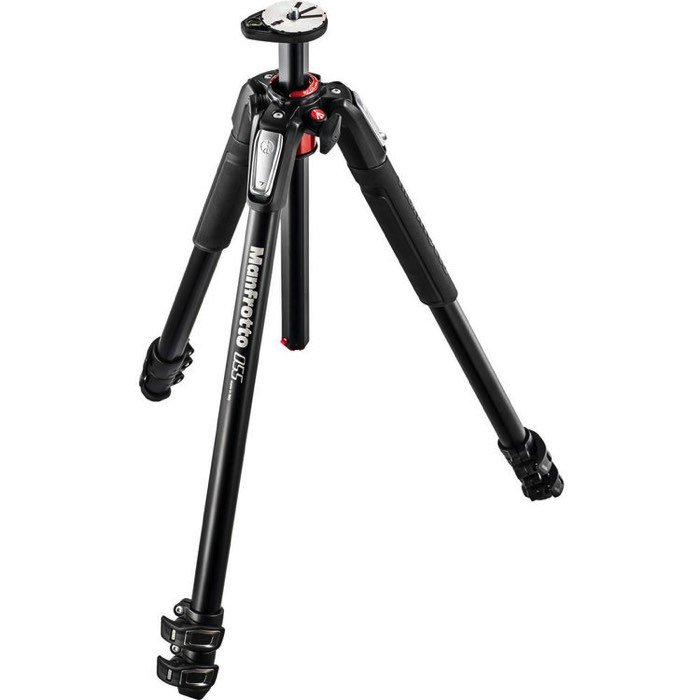
This full-size tripod has great user reviews on Amazon and other reputable sites, with many praising its stability.
Here a list of relevant features:
- Load Capacity: 19.8 lb / 9 kg
- Maximum Working Height: 66.9″ / 169.9 cm and 55.1″ / 140 cm without rising center column
- Minimum Working Height: 3.5″ / 8.9 cm
- Folded Length: 24″ / 61 cm
- Weight: 5.5 lb / 2.5 kg
- Independent Leg Spread: Yes
- Leg Sections: 3
- Lateral / 90-Degree Center Column: Yes
Being a full-size tripod, it does not fold into a nice compact, light, and airplane-friendly package (the carbon fiber version still weighs 4.3 lb /2 kg), but if you can deal with its dimensions you will be gifted with great stability and a massive 64″/ 160 cm working height range.
Mind, though, that Manfrotto does not include a head with this tripod: this is not so great if it is your first tripod, but perfect if you are upgrading from an older tripod and want to keep your old head.
Alternatives: Manfrotto 190XPRO3 or Manfrotto 290 XTRA 3
For Amateur and Travel Photographers: MeFOTO RoadTrip Travel Tripod (Classic)
MeFOTO is a relatively new brand of tripods, designed to be the ideal travel companion while still remaining a fully functional and robust camera-support system.
They offer a whole range of products, from tabletop tripods up to travel tripods incorporating numerous qualities that rival those of full-size tripods. Both aluminum and carbon fiber tripods are present in their lineupThe RoadTrip Travel tripod can be purchased from Amazon directly from MeFOTO and is available in aluminum and in carbon fiber.
For the price (particularly the aluminum version) it is a great kit for the amateur travel photographer who is always on the move, as it comes with a ball head, carry case and one leg can be used as monopod.
Here is the list of interesting features:
- Ball head using standard Arca Swiss plate sporting independent panning movement
- The head can be removed
- Max load: 17.6 lb (8.0 kg)
- Maximum Height: 61.6″ (156.5 cm) and 53.1″ (130.3 cm) w/o Column Extended
- Minimum Height: 15.4″ (39.1 cm) or 12″ with the optional short column
- Folded Length: 15.4″ (39.1 cm)
- A leg can be converted to full-size monopod
- Independent Leg Spread: Yes
- Weight 3.6 lb (1.6 kg)
- Carry case included
The trade-off for such compact size and portability is that it has 5-sectioned legs and because of this, its stability, particularly with very heavy loads, may not be optimal.
The reviews of this tripod are great on Amazon and on reputable shops such B&H Photo.
As this is the ‘big brother’ of my even smaller and lighter MeFOTO Backpacker, I can vouch for the fact that it is a great tripod kit for amateur travel landscape photographers at a reasonable price.
Alternatives: Manfrotto BeFree, Vanguard VEO 265AB
For Lightweight Landscape Photography: Joby Gorillapod SLR Zoom
The Joby Gorillapod is a well-known compact tripod created to wrap around trees, poles and other objects, so as to give you the maximum flexibility in setting up your camera by taking advantage of what there is nearby.
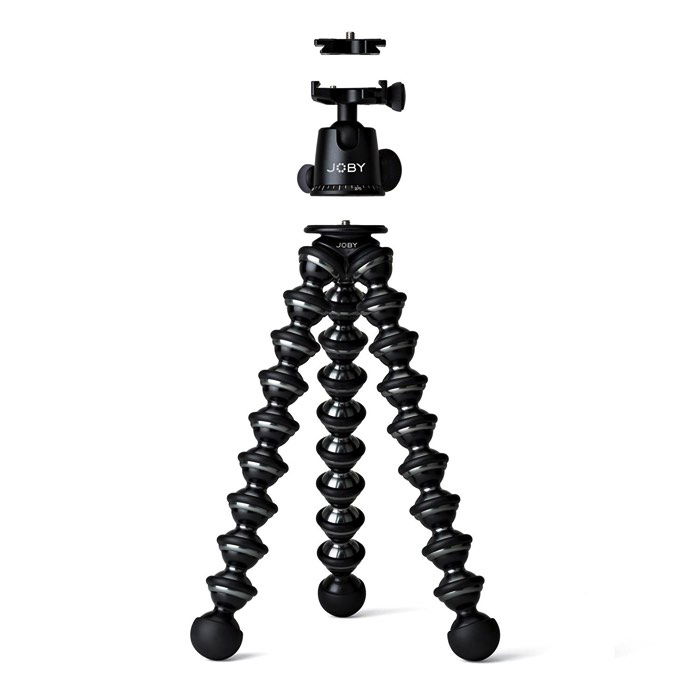
When compared to my MeFOTO Backpacker compact tripod, the Gorillapod is, when folded, 15cm longer (47 cm Vs 32 cm), but it is 450 grams lighter (0.76 kg vs 1.2 kg) and it can support 5 kg instead of 4 kg.
Mind that while it can support 5 kg in ideal positions, I wouldn’t trust it to support your precious, heavy, full frame DSLR with 70-200 f/2.8 zoom lens while wrapped on a tree. It is reasonably safe, though, to do so with compact and lightweight mirrorless cameras.
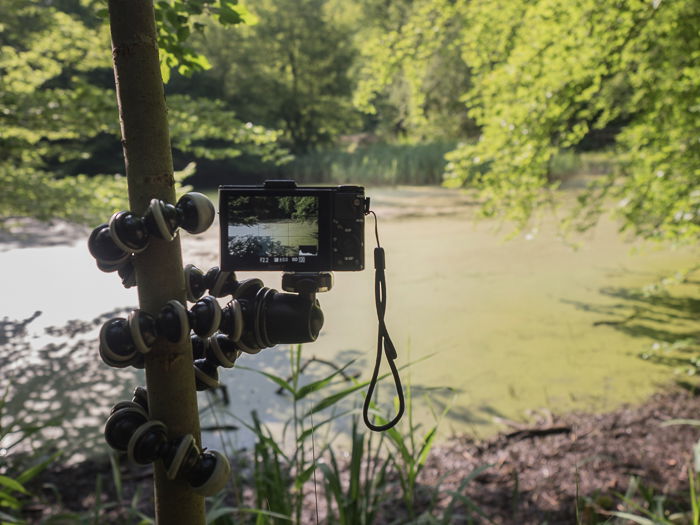
Because of the huge range of photographic opportunities that this tripod can unlock, and considering its affordable price, it should be in every landscape photographer bag.
Alternatives: Joby Gorillapod SLR Zoom or MeFOTO Backpacker
Tripod Heads for Landscape Photography
Many kinds of heads are available from all tripod manufacturers. Some heads are of general purposes, such as 3-way and ball heads, while some are more specific, as video, gimbal, and geared heads.
Some heads use a proprietary plate, while others adopt the more standard Arca Swiss plate.
Ball Heads
One of the most common heads is the ball head, where the plate is mounted on a ball joint allowing the camera to move in all directions.
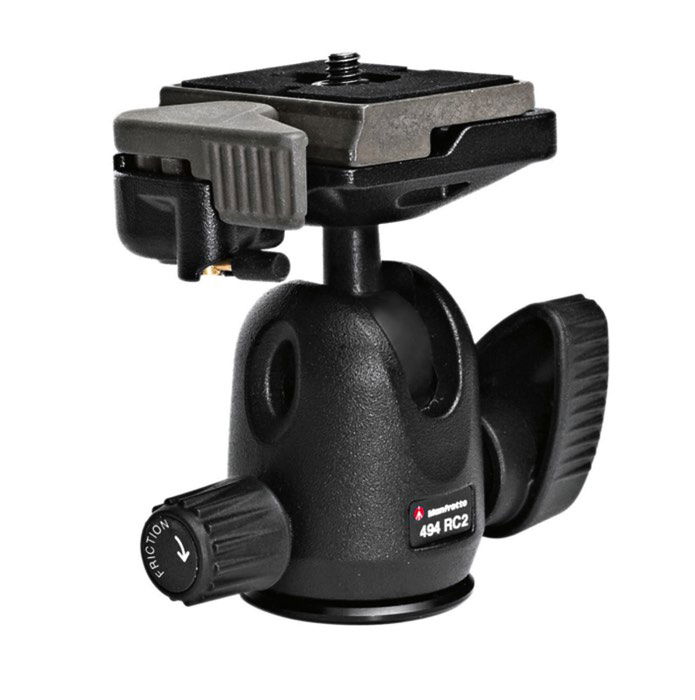
Pros:
- Light and simple to operate
- It allows one to quickly compose the scene
- The friction mechanism allows for more controlled and smooth camera movements
Cons:
- Precision: after composing and tightening all knobs, under its own weight the camera will probably slip downward a little
- Impossible to easily adjust the camera position in only one direction, as loosening up the knob will make the camera move in all directions
Sometimes, ball heads have an independent panning movement, where the head rotates on its base. This make easier to do some adjustments as well as shooting for simple panoramas and video panning.
3-Way Pan & Tilt Heads
With this kind of head each direction for the camera movement (up/down, left/right, and the tilt landscape/portrait orientation) can be adjusted independently.
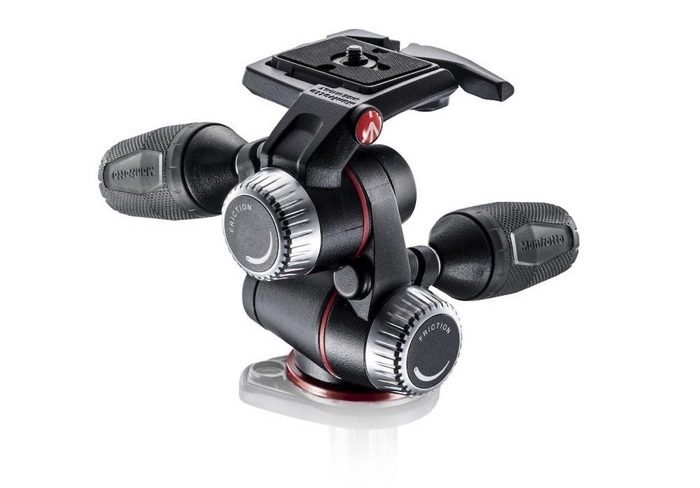
Pros:
- Precise
- Independent movement on three axes
- Enables horizontal and vertical panoramas and video panning
- Can take more weight than ball heads
Cons:
- Bulkier than ball heads due to the protruding adjustment knobs
- Slower to operate than ball heads
- Good heads are generally more expensive than good ball heads
Panoramic Heads
Panoramic heads are quite specific and are used to create a photographic sequence to be later stitched together into a single, large panoramic view.
Your camera has to move in a very controlled way from one exposure to another: vertical and horizontal position of the camera and precise rotations are required, as well as the ability to position the nodal point of the camera on the rotational axis to eliminate parallax.
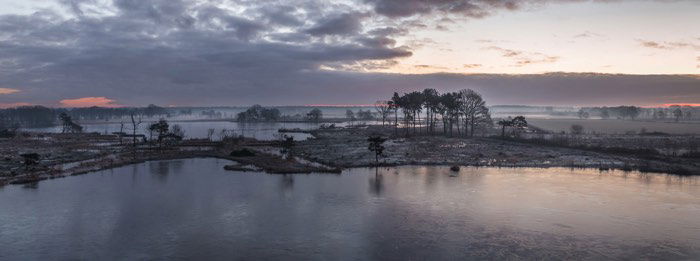
Panoramas are usually done with the camera in portrait orientation. Thus an L-bracket, which holds the camera that position, is a must.
The best panoramic heads have one major downside: they are very expensive. However, more affordable models that work fine for lightweight equipment and non-professional photography can be purchased.
Conclusions
Now you know all you need to choose the best tripod for landscape photography that fits your budget.
Once you’ve got one, all you need to do is step outside and let the outdoors inspire your photography, knowing your gear is safe and stable on your new tripod.



